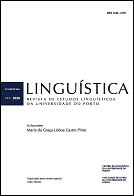Orality reading and understanding: how readers and non-readers understand the argumentative "mas"
Abstract
This piece of research aimed at investigating the role of reading knowledge in the manner of understanding oral statements whose interphrasal relation is constituted by mas as an argumentative articulator of opposition. Following Olson (1977, 1996, 1997, 1999, 2009) and Olson and Oatley (2013), who argue that reading can cause changes in the way oral verbal language is processed, the general hypothesis of the study is that knowing to read influences the comprehension of oral statements linked by mas, as reading may serve as a model to understand and analyze linguistic units, favoring the understanding of this element as an argumentative articulator of opposition among implicit contents. To conduct this research, an experiment was carried out with 19 adult students divided into two groups: readers and non readers. The participants were invited to judge grammaticality of stimuli, and the accuracy and response time (RT) of the participants were evaluated. The results allowed us to conclude, through hypothesis validity, that the accuracy indicated a significantly superior success of the group of participants classified as being readers. Besides, qualitative differences observed in the RT suggest that the readers group was able to perceive the ungrammaticality of the statements.
References
Alvermann, Donna E., Unrau, Norman J., & Ruddell, Robert B. (2013). Theoretical Models and Processes of Reading (6th. ed). Newark, DE: International Reading Association.
Bingham, Adelaide Bates, (1986). Readers’ and listeners’ use of cohesive ties in processing relational meaning. Language Sciences, 8(1) 49-61.
Cain, Kate, & Nash, Hannah M. (2011). The influence of connectives on young readers’ processing and comprehension of text. Journal of Educational Psychology, 103(2), 429-441.
Ducrot, Oswald. (1988). Polifonia y argumentación. Cali: Universidad del Valle.
Flood, James (ed.). (1984). Understanding reading comprehension. Newark, Delaware: International Reading Association.
Forster, Jonathan, & Forster, Kenneth. (2015). DMDX Display Software. Disponível em: http://www.u.arizona.edu/~kforster/dmdx/dmdx.htm. Acesso em: 05 jul. 2015.
Kail, Michèle. (1978). La compréhension des présuppositions chez I’enfant. L’Anée psychologique, 78, 425-444.
Kail, Michèle. (2013). Aquisição de linguagem [L’Acquisition du langage]. São Paulo: Parábola.
Kail, Michèle, & Weissnborn, Jürgen. (1984). A developmental crosslinguistic study of adversative connectives: French “mais” and German “aber/sodern”. Journal of Child Language, 11, 143-158.
Kail, Michèle, & Weissnborn, Jürgen. (1991). Conjuctions: Developmental Issues. In Gilberte Piéraut-Le-Bonniec, & Marlene Dolitsky (Eds.), Language Bases: Discourse Bases (pp.125-142. Amsterdam: Benjamins.
Kamil, Michael L., Pearson, P. David, Moje, Elizabeth Birr, & Afflerbach, Peter P. (2011). Handbook of Reading Research – vol. IV. Nova Iorque: Routledge.
Morais, José, & Kolinsky, Règine. (2013). Letramento e mudança cognitiva. In Margaret J. Snowling, & Charles Hulme (Org.), A ciência da leitura (pp. 207-222). Porto Alegre: Penso.
Oakhill, Jane, Cain, Kate, & Elbro, Carsten. (2017). Compreensão de leitura: teoria e prática [Understanding and Teaching Reading Comprehension: a Handbook]. São Paulo: Hogrefe.
Olson, David R. (1977). From utterance to text: the bias of language in speech and writing. Harvard Educational Review, 47, 257-281.
Olson, David R. (1996). Towards a psychology of literacy: on the relations between speech and writing. Cognition, 60, 83-104.
Olson, David R. (1997). O mundo no papel: as implicações conceituais e cognitivas da leitura e da escrita. São Paulo, Ática.
Olson, David R. (1999). Literacy. In Robert A. Wilson, & Frank Keil (Eds.). MIT Encyclopedia of Cognitive Science. Cambridge, MA: MIT Press.
Olson, David R. (2009). Language, literacy and mind: The Literacy Hypothesis. Psykhe, Santiago, 18(1), 3-9.
Olson, David R., & Oatley, Keith. (2013). The Quotation Theory of Writing. Written Communication, 31(1), 4-26. doi: 10.1177/0741088313515164.
Perfetti, Charles. A., Landi, Nicole, & Oakhill, Jane. (2013). A aquisição da habilidade de compreensão da leitura. In Margaret J. Snowling, & Charles Hulme (Org.), A ciência da leitura (pp. 245-265). Porto Alegre: Penso.
Perfetti, Charles. A., Van Dyke, Julie, & Hart, Lesley. (2001). The psycholinguistics of basic literacy. Annual Review of Applied Linguistics, 21, 127-149.
Pinto, Maria da Graça Castro. (2019). Uma breve abordagem à leitura e à escrita na perspectiva da Psicolinguística. In Ana Cláudia de Souza, Cristiane Seimetz-Rodrigues, Claudia Finger-Kratochvil, Luciane Baretta, & Angela Cristina Di Palma Back (Org.), Diálogos linguísticos para a leitura e a escrita (pp. 85-106). Florianópolis: Insular.
Ruddell, Robert B, Ruddell, Martha Rapp, & Singer, Harry (ed.). (1994). Theoretical models and processes of reading (4th ed). Newark, Delaware: International Reading Association.
Snowling, Margaret J., & Hulme, Charles (Org.). (2013). A ciência da leitura [The Science of Reading: a Handbook]. Porto Alegre: Penso.
Souza, Ana Cláudia de, Seimetz-Rodrigues, Cristiane, Finger-Kratochvil, Claudia; Baretta, Luciane, & Back, Angela Cristina Di Palma (Org.). (2019). Diálogos linguísticos para a leitura e a escrita. Florianópolis: Insular, 2019.
Souza, Ana Cláudia de, Weirich, Helena Cristina, & Procailo, Leonilda. (2017). A compreensão da argumentação linguística: hipótese de interação entre leitura e oralidade. Revista de Estudos da Linguagem, 25(2), 873-901. doi: 10.17851/2237- 2083.25.2.873-901.
Weirich, Helena Cristina. (2016). Domínio da leitura e compreensão oral do “mas” argumentativo. Orientadora: Ana Cláudia de Souza. (Dissertação de mestrado não publicada) Universidade Federal de Santa Catarina, Florianópolis, Brasil. Disponível em: http://tede.ufsc.br/teses/PLLG0652-D.pdf.
Downloads
Published
Issue
Section
License
Copyright (c) 2020 Linguística: Revista de Estudos Linguísticos da Universidade do Porto

This work is licensed under a Creative Commons Attribution-NonCommercial 4.0 International License.



